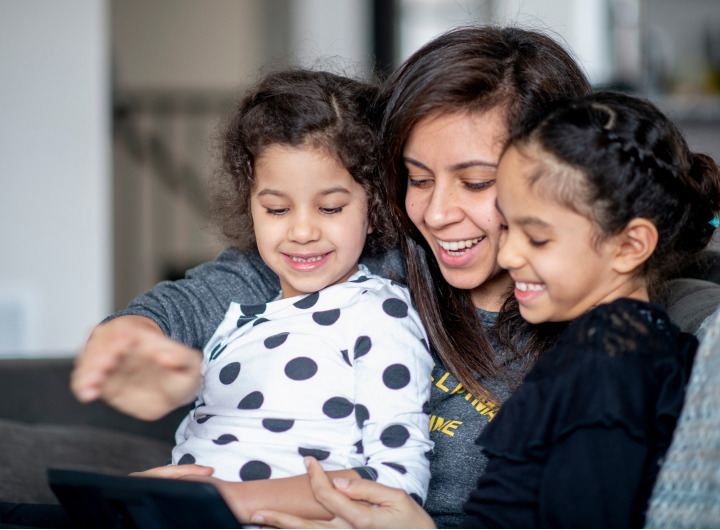Pressing pause on tech tantrums

Picture this: your child is deeply engaged in their favourite video game. They're in the zone, immersed and focused on every tap and click. You let them know that game time’s over – cue the stress of being ignored by your child, or your child resisting doing as they are asked. Sound familiar? Or perhaps your younger tamariki is watching their favourite episode of that show! – equally absorbed. You're not alone. Screen time irritability and resistance are familiar struggles, but they don’t mean you’re doing anything wrong. With a few well-tested tips, you can turn tech troubles and tablet tantrums into teachable moments.
Remember, it’s not just about the game. When kids are in front of a screen, especially if they’re enjoying it, they can easily lose track of time. What feels like ‘five more minutes’ to them might have been 50. That’s because screens can pull them into a kind of digital tunnel vision, where their sense of time evaporates. We've all been there!
Understand why screens bring out big feelings
Screens aren’t just fun; they’re designed to keep us coming back for more. Many apps and games give little dopamine rewards (the brain’s feel-good chemical) that make it harder to step away. So, when the screen goes off, children are not just losing the game or their favourite episode, they’re going from big fun to zero fun in an instant. For children who are still learning how to manage big emotions, that’s a tough landing.
Giving them a gentle heads-up a few minutes before unplugging can often make the transition less jarring and help curb strong reactions to screen time limits.
Look out for warning signs of too much screen time
Not all screen time is created equal, but when does being engaged with screens become concerning? What are some red flags? If your child has trouble sleeping, resists switching off or seems bored by other activities, it could be time to review how much they’re on devices.
- You might also notice mood swings, grumpiness, or signs like rubbing eyes or complaining of headaches.
- They may also lose interest in playing outside or spending time with friends.
These can be signs of screen overload, or even exposure to content that may not be right for their age. If you’re seeing a few of these in your home, don’t panic. These are signals, not failures and can be tweaked to help you create healthy limits and reduce screen time for your tamariki.
Establish healthy tech habits in early childhood
Toddlers are sponges, soaking up routines and behaviours from what they see around them. It’s easy to slip into screen time as a go-to for kids, but there are other simple, everyday things that can keep them engaged and calm, too.
You can begin making small changes by:
- Preparing ahead by having an activity ready to go to replace the screen. Offering toddlers simple, fun alternatives like colourful blocks, pegs and puzzles can help.
- Making screen free times predictable, like before naps, meals and bedtime, so they’re not overstimulated.
- Using visual timers to show how long screen time lasts and letting them know – no surprises means fewer tantrums!
- Praise or thank them when they calmly switch off from screen time.
It’s tempting to give in and hand over a device when your toddler is grumbling, or you just need five quiet minutes (we’ve all been there!). But if it becomes a regular pattern, they may start to expect screens when they’re upset, rather than learning to manage big feelings in other ways. Setting them up for success by creating screen time limits early on, is a great plan.
Help school-aged kids balance excessive screen time with real life
Once kids hit school age, tech becomes a bigger part of learning, connecting and relaxing. But kids still need boundaries and their caregivers to be tech role models. Even the most educational app can’t replace physical activity or hanging out with a friend face-to-face.
Involving your kids in setting screen limits, can make it feel more like a team effort. You might consider the following:
- Try building screen time into a routine that includes other daily activities like chores and playing outside.
- Keep bedrooms screen free to help with relaxing and sleep.
- Every now and then, it's fun to join them in their digital world. Playing video games or watching an episode together can be a great way to bond over something they love.
- Using regular verbal reminders and visual timers – this works across all ages and development stages. These are especially helpful for children who are neurodivergent, including those who may be on the Autism spectrum, be diagnosed with ADHD or have other additional needs.
Screentime is also a time when they might come across things they’re not ready for. Having regular check-ins about what they're watching online and keeping screens in open spaces can help if they do see inappropriate or upsetting content.
Keeping up with what they’re watching or playing gives you more chances to talk about tricky topics early and support good choices. It also helps you understand how and why they’re using screens – which can be important for primary school kids who are still learning how to manage emotions, especially after a long day.
Having clear screen time routines can help avoid tantrums, while regularly modelling your own tech behaviour shows kids what consistency looks like. It’s also worth noting that some kids use screens to calm down or self-regulate, which can be factored in when setting boundaries.
Back your teen in building a positive relationship with tech
Teenagers live a lot of their lives online. Social media, video games, messaging, it’s how they relax, connect and stay in the loop with each other. But when the balance tips too far, it can affect their sleep, their mental health and they can lose awareness of other important things in their life.
With teens, the best way is through it, not around it - so start by talking openly about what their online experiences are like and any worries they have. You could ask, “what do you like or dislike about these apps?” Or, "how do you feel while or after using the app?” You can also work together to spot when platforms use strategies designed to keep them hooked, such as the use of rewards or streaks, and discuss these with your child. Then, create tech-free zones and times the whānau sticks to like during dinner, when engaged in conversations with each other, or before bed. Involving them in setting tech boundaries helps them feel their opinions are valued – and they’re more likely to stick with them. It can also lead to less conflict and a more peaceful home!
If you feel like their usage has become a real problem – despite your best attempts at balance – rather than jumping straight to restrictions or bans, try and talk about it in a calm way. Ask them if they feel their screen time is too much. Remind them again that many apps are designed for this, and dependence or overuse can sneak up on any of us – it’s not just them.
From there you can both work toward solutions like:
- Committing to regular phone/screen/gaming free times and building in longer breaks.
- Prioritising screen free social activities like sport, clubs, a hobby or art classes – choose something fun together if it’s a new idea.
- If you feel you need help, remember it’s a sign of strength to seek advice, whether from a mental health professional or GP – teen screen addiction can be hard to manage alone.
Create a family culture of striving, not perfection
There’s no perfect formula for screen time – even adults struggle with it. What matters is finding a rhythm that works for your family.
Set up screen free zones like bedrooms or when people are talking to each other – we want all their attention, right? Try regular 'unplugging' moments together. Maybe a walk around the block after dinner, a board game challenge or charades in the kitchen! And when things go smoothly, call it out using descriptive praise such as “good job turning off your tablet when the alarm went off like we agreed or for older kids—"thanks for getting off your phone and being present”.
And if your whānau start to slip back into old habits? That’s okay. Screens aren’t going anywhere. Just notice what’s changed, then talk to your kids about how to bring those tech boundaries back on track – together.
For more tips and strategies to help build your skills and be able to address challenging child behaviour, visit Triple P Online.

